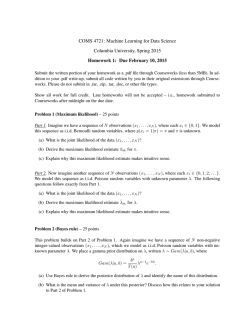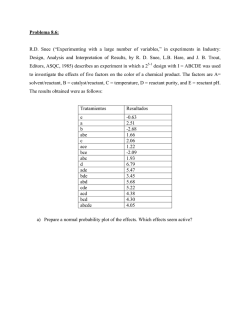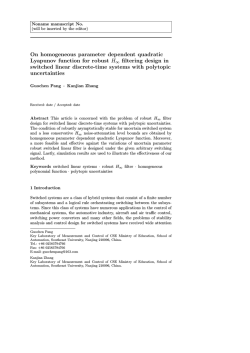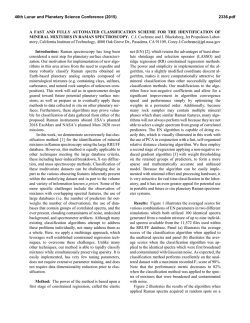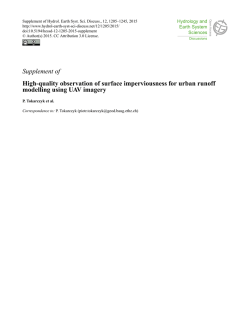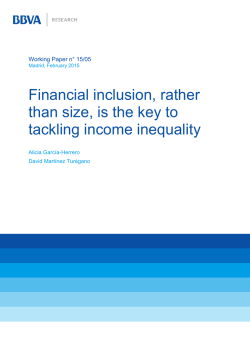
Heteroskedasticity - University of Notre Dame
Heteroskedasticity
Richard Williams, University of Notre Dame, http://www3.nd.edu/~rwilliam/
Last revised January 30, 2015
These notes draw heavily from Berry and Feldman, and, to a lesser extent, Allison, and Pindyck and Rubinfeld.]
What heteroskedasticity is. Recall that OLS makes the assumption that
V (ε j ) = σ 2 for all j. That is, the variance of the error term is constant. (Homoskedasticity). If the
error terms do not have constant variance, they are said to be heteroskedastic. [Tidbit from
Wikipedia: The term means “differing variance” and comes from the Greek “hetero” ('different')
and “skedasis” ('dispersion').]
When heteroskedasticity might occur.
•
Errors may increase as the value of an IV increases. For example, consider a model in which
annual family income is the IV and annual family expenditures on vacations is the DV.
Families with low incomes will spend relatively little on vacations, and the variations in
expenditures across such families will be small. But for families with large incomes, the
amount of discretionary income will be higher. The mean amount spent on vacations will be
higher, and there will also be greater variability among such families, resulting in
heteroskedasticity.
Note that, in this example, a high family income is a necessary but not sufficient condition
for large vacation expenditures. Any time a high value for an IV is a necessary but not
sufficient condition for an observation to have a high value on a DV, heteroskedasticity is
likely.
Similar examples: Error terms associated with very large firms might have larger variances
than error terms associated with smaller firms. Sales of larger firms might be more volatile
than sales of smaller firms.
•
Errors may also increase as the values of an IV become more extreme in either direction, e.g.
with attitudes that range from extremely negative to extremely positive. This will produce
something that looks like an hourglass shape:
Heteroskedasticity
Page 1
4
2
0
e1
-2
-4
-6
-2
-1
0
x
1
2
•
Measurement error can cause heteroskedasticity. Some respondents might provide more
accurate responses than others. (Note that this problem arises from the violation of another
assumption, that variables are measured without error.)
•
Heteroskedasticity can also occur if there are subpopulation differences or other interaction
effects (e.g. the effect of income on expenditures differs for whites and blacks). (Again, the
problem arises from violation of the assumption that no such differences exist or have
already been incorporated into the model.) For example, in the following diagram suppose
that Z stands for three different populations. At low values of X, the regression lines for each
population are very close to each other. As X gets bigger, the regression lines get further and
further apart. This means that the residual values will also get further and further apart.
•
Other model misspecifications can produce heteroskedasticity. For example, it may be that
instead of using Y, you should be using the log of Y. Instead of using X, maybe you should
be using X2, or both X and X2. Important variables may be omitted from the model. If the
model were correctly specified, you might find that the patterns of heteroskedasticity
disappeared.
Consequences of heteroskedasticity. Note that heteroskedasticity is often a by-product of
other violations of assumptions. These violations have their own consequences which we will
deal with elsewhere. For now, we’ll assume that other assumptions except heteroskedasticity
have been met. Then,
•
Heteroskedasticity does not result in biased parameter estimates.
Heteroskedasticity
Page 2
•
However, OLS estimates are no longer BLUE. That is, among all the unbiased estimators,
OLS does not provide the estimate with the smallest variance. Depending on the nature of the
heteroskedasticity, significance tests can be too high or too low. As Allison puts it: “The
reason OLS is not optimal when heteroskedasticity is present is that it gives equal weight to
all observations when, in fact, observations with larger disturbance variance contain less
information than observations with smaller disturbance variance.”
•
In addition, the standard errors are biased when heteroskedasticity is present. This in turn
leads to bias in test statistics and confidence intervals.
•
Fortunately, unless heteroskedasticity is “marked,” significance tests are virtually unaffected,
and thus OLS estimation can be used without concern of serious distortion. But, severe
heteroskedasticity can sometimes be a problem.
Warning: Heteroskedasticity can be very problematic with methods besides OLS. For example,
in logistic regression heteroskedasticity can produce biased and misleading parameter estimates.
I talk about such concerns in my categorical data analysis class.
Detecting Heteroskedasticity
Visual Inspection. Do a visual inspection of residuals plotted against fitted values; or, plot the
IV suspected to be correlated with the variance of the error term. In Stata, after running a
regression, you could use the rvfplot (residuals versus fitted values) or rvpplot command
(residual versus predictor plot, e.g. plot the residuals versus one of the X variables included in
the equation). In SPSS, plots could be specified as part of the Regression command.
In a large sample, you’ll ideally see an “envelope” of even width when residuals are
plotted against the IV. In a small sample, residuals will be somewhat larger near the mean
of the distribution than at the extremes. Thus, if it appears that residuals are roughly the
same size for all values of X (or, with a small sample, slightly larger near the mean of X)
it is generally safe to assume that heteroskedasticity is not severe enough to warrant
concern.
If the plot of residuals shows some uneven envelope of residuals, so that the width of the
envelope is considerably larger for some values of X than for others, a more formal test
for heteroskedasticity should be conducted.
Breusch-Pagan / Cook-Weisberg Test for Heteroskedasticity. The Breusch-Pagan test is
designed to detect any linear form of heteroskedasticity. You run a regression, and then give the
estat hettest command (or, hettest alone will work). Using the reg01 data,
Heteroskedasticity
Page 3
. use http://www3.nd.edu/~rwilliam/statafiles/reg01.dta, clear
. reg income educ jobexp
Source |
SS
df
MS
-------------+-----------------------------Model | 1538.22521
2 769.112605
Residual | 282.200265
17 16.6000156
-------------+-----------------------------Total | 1820.42548
19 95.8118671
Number of obs
F( 2,
17)
Prob > F
R-squared
Adj R-squared
Root MSE
=
=
=
=
=
=
20
46.33
0.0000
0.8450
0.8267
4.0743
-----------------------------------------------------------------------------income |
Coef.
Std. Err.
t
P>|t|
[95% Conf. Interval]
-------------+---------------------------------------------------------------educ |
1.933393
.2099494
9.21
0.000
1.490438
2.376347
jobexp |
.6493654
.1721589
3.77
0.002
.2861417
1.012589
_cons | -7.096855
3.626412
-1.96
0.067
-14.74791
.5542051
-----------------------------------------------------------------------------. estat hettest
Breusch-Pagan / Cook-Weisberg test for heteroskedasticity
Ho: Constant variance
Variables: fitted values of income
chi2(1)
Prob > chi2
=
=
0.12
0.7238
Breusch-Pagan / Cook-Weisberg tests the null hypothesis that the error variances are all equal
versus the alternative that the error variances are a multiplicative function of one or more
variables. For example, in the default form of the hettest command shown above, the
alternative hypothesis states that the error variances increase (or decrease) as the predicted
values of Y increase, e.g. the bigger the predicted value of Y, the bigger the error variance is. A
large chi-square would indicate that heteroskedasticity was present. In this example, the chisquare value was small, indicating heteroskedasticity was probably not a problem (or at least that
if it was a problem, it wasn’t a multiplicative function of the predicted values).
Besides being relatively simple, hettest offers several additional ways of testing for
heteroskedasticity; e.g. you could test for heteroskedasticity involving one variable in the model,
several or all the variables, or even variables that are not in the current model. Type help
hettest or see the Stata reference manual for details.
See Appendix A for details on how and why hettest works.
White’s General Test for Heteroskedasticity. The default Breusch-Pagan test specified by
hettest is a test for linear forms of heteroskedasticity, e.g. as yˆ goes up, the error variances
go up. In this default form, the test does not work well for non-linear forms of heteroskedasticity,
such as the hourglass shape we saw before (where error variances got larger as X got more
extreme in either direction). The default test also has problems when the errors are not normally
distributed.
Heteroskedasticity
Page 4
White’s general test for heteroskedasticity (which is actually a special case of Breusch-Pagan)
can be used for such cases. This can be estimated via the command estat imtest, white
or just imtest, white. (Actually, the white option seems to matter rarely if ever in my
experience; the Stata help says “White's test is usually very similar to the first term of the
Cameron-Trivedi decomposition” normally reported by imtest.) You can also use Mark
Schaffer’s ivhettest (which offers several additional capabilities) or Baum & Cox’s
whitetst, both available from SSC. As the help for whitetst states,
whitetst computes the White (1980) general test for heteroskedasticity in the error distribution
by regressing the squared residuals on all distinct regressors, cross-products, and squares of
regressors. The test statistic, a Lagrange multiplier measure, is distributed Chi-squared(p) under
the null hypothesis of homoskedasticity. See Greene (2000), pp. 507-511.
NOTE: Part of the reason the test is more general is because it adds a lot of terms to test for more
types of heteroskedasticity. For example, adding the squares of regressors helps to detect
nonlinearities such as the hourglass shape. In a large data set with many explanatory variables,
this may make the test difficult to calculate. Also, the addition of all these terms may make the
test less powerful in those situations when a simpler test like the default Breusch-Pagan would be
appropriate, i.e. adding a bunch of extraneous terms may make the test less likely to produce a
significant result than a less general test would.
Here is an example using estat imtest, white:
. use http://www.nd.edu/~rwilliam/statafiles/reg01.dta, clear
. quietly reg income educ jobexp
. estat imtest, white
White's test for Ho: homoskedasticity
against Ha: unrestricted heteroskedasticity
chi2(5)
Prob > chi2
=
=
8.98
0.1100
Cameron & Trivedi's decomposition of IM-test
--------------------------------------------------Source |
chi2
df
p
---------------------+----------------------------Heteroskedasticity |
8.98
5
0.1100
Skewness |
2.39
2
0.3022
Kurtosis |
0.98
1
0.3226
---------------------+----------------------------Total |
12.35
8
0.1363
---------------------------------------------------
As noted before, White’s general test is a special case of the Breusch-Pagan test, where the
assumption of normally distributed errors has been relaxed (to do this, use the iid option of
hettest) and an auxiliary variable list (i.e. the Xs, the Xs squared and the crossproduct/interaction terms) is specified:
Heteroskedasticity
Page 5
. quietly reg income educ jobexp
. estat hettest educ jobexp c.educ#c.educ c.jobexp#c.jobexp c.educ#c.jobexp, iid
Breusch-Pagan / Cook-Weisberg test for heteroskedasticity
Ho: Constant variance
Variables: educ jobexp c.educ#c.educ c.jobexp#c.jobexp c.educ#c.jobexp
chi2(5)
Prob > chi2
=
=
8.98
0.1100
See Appendix A for details on how and why imtest works.
Other Tests. There are lots of other tests for heteroskedasticity. They make different
assumptions about the form of heteroskedasticity, whether or not error terms are normally
distributed, etc. The readings go over some of these and if you give the command
findit heteroskedasticity from within Stata you’ll come up with more options.
Appendix B discusses the Goldfeldt-Quant test, which is somewhat antiquated, but which you
may occasionally come across in your reading.
Dealing with heteroskedasticity
1.
Respecify the Model/Transform the Variables. As noted before, sometimes
heteroskedasticity results from improper model specification. There may be subgroup
differences. Effects of variables may not be linear. Perhaps some important variables have been
left out of the model. If these are problems deal with them first!!! Don’t just launch into other
techniques, such as WLS, because they don’t get to the heart of the problem.
Incidentally, Allison says (p. 128) “My own experience with heteroskedasticity is that is has to
be pretty severe before it leads to serious bias in the standard errors. Although it is certainly
worth checking, I wouldn’t get overly anxious about it.”
Warning: In general, I agree, with the qualifier that heteroskedasticity that results from model
mis-specification is something to be concerned about. Indeed, I would say in such cases the
problem isn’t really heteroskedasticity, it is model mis-specification; fix that problem and the
heteroskedasticity may go away. HOWEVER, by checking for heteroskedasticity, you may be
able to identify model specification problems. So, I would probably be a little more anxious
about heteroskedasticity than Allison implies.
2.
Use Robust Standard Errors. Stata includes options with most routines for estimating
robust standard errors (you’ll also hear these referred to as Huber/White estimators or sandwich
estimators of variance). As noted above, heteroskedasticity causes standard errors to be biased.
OLS assumes that errors are both independent and identically distributed; robust standard errors
Heteroskedasticity
Page 6
relax either or both of those assumptions. Hence, when heteroskedasticity is present, robust
standard errors tend to be more trustworthy.
With regards to the related problem of error terms not being independent: Survey data are often collected using
clustering, e.g. a sample will be drawn of areas and individuals within those areas will then be selected for inclusion
in the sample. Also, some groups will be deliberately oversampled, e.g. your sampling scheme might be set up to
include a disproportionately large number of minorities, in order to ensure that you have enough minorities to do
subsample analyses of them. Such strategies can lead to violations of the assumption that the error terms are
independent of each other (since people sampled in clusters tend to be more similar than people sampled totally at
random). There is a good discussion of this in “Sampling Weights and Regression Analysis” by Winship and
Radbill, Sociological Methods and Research, V. 23, # 2, Nov 1994 pp. 230-257.
Another example (given by Hamilton in Statistics with Stata, Updated for Stata 9, pp. 258-259: 51 college students
were asked to rate the attractiveness of photographs of unknown men and women. The procedure was reported 4
times, producing 204 sets of records. Hamilton says “It seems reasonable to assume that disturbances (unmeasured
influences on the ratings) were correlated across the repetitions by each individual. Viewing each participant’s four
rating sessions as a cluster should yield more realistic standard errors.” In this case you add the cluster(id)
option to the regression command, where id is the id number of the subject.
As Allison points out, the use of robust standard errors does not change coefficient estimates, but
(because the standard errors are changed) the test statistics will give you reasonably accurate p
values. The use of Weighted Least Squares (described next) will also correct the problem of bias
in the standard errors, and will also give you more efficient estimates (i.e. WLS will give you
estimates that have the smallest possible standard errors). But, WLS requires more assumptions
and is more difficult to implement, so robust standard errors seem to be a more common and
popular method for dealing with issues of heteroskedasticity.
With Stata, robust standard errors can usually be computed via the addition of two parameters,
robust and cluster. The robust option relaxes the assumption that the errors are
identically distributed, while cluster relaxes the assumption that the error terms are
independent of each other. For example, rerunning the above regression with the robust
option, we get
. reg
income educ jobexp, robust
Regression with robust standard errors
Number of obs =
F( 2,
17) =
Prob > F
=
R-squared
=
Root MSE
=
20
48.15
0.0000
0.8450
4.0743
-----------------------------------------------------------------------------|
Robust
income |
Coef.
Std. Err.
t
P>|t|
[95% Conf. Interval]
-------------+---------------------------------------------------------------educ |
1.933393
.2006214
9.64
0.000
1.510119
2.356667
jobexp |
.6493654
.1701214
3.82
0.001
.2904407
1.00829
_cons | -7.096855
3.365609
-2.11
0.050
-14.19767
.0039603
------------------------------------------------------------------------------
Note: You can also give the command
. reg income educ jobexp, vce(robust)
which is actually the preferred syntax for newer versions of Stata.
Heteroskedasticity
Page 7
Comparing the results with the earlier regression, you note that none of the coefficient estimates
changed, but the standard errors and hence the t values are a little different. Had there been more
heteroskedasticity in these data, we would have probably seen bigger changes.
In some cases, Stata will use robust standard errors whether you explicitly ask for them or not.
For example, if you have used clustering when collecting your data (and you tell Stata this via
use of the cluster parameter) the error terms will not be independent. Hence, if you ever
wonder why you are getting robust standard errors when you did not ask for them, it is probably
because robust standard errors are more appropriate for what you are doing. (Indeed, with more
complicated analyses, Stata will often surprise you by doing things you don’t expect; if you can
figure out why, you will learn a lot about advanced statistics!)
Caution: Do not confuse robust standard errors with robust regression. Despite their similar
names, they deal with different problems:
Robust standard errors address the problem of errors that are not independent and identically
distributed. The use of robust standard errors will not change the coefficient estimates provided
by OLS, but they will change the standard errors and significance tests.
Robust regression, on the other hand, deals with the problem of outliers in a regression. Robust
regression uses a weighting scheme that causes outliers to have less impact on the estimates of
regression coefficients. Hence, robust regression generally will produce different coefficient
estimates than OLS does.
3.
Use Weighted Least Squares. A more difficult option (but superior when you can
make it work right) is the use of weighted least squares.
Weighted Least Squares is a more advanced method that I don’t see sociologists using that often.
It is therefore covered in the optional but recommended Appendix C.
4. Summary of recommendations for dealing with heteroskedasticity. In most instances, I
would recommend option 1 (respecify the model or transform the variables) or option 2 (robust
standard errors). Most of the examples I have seen using Stata take those approaches. However,
in special cases, option 3 (WLS) can be the best. What makes WLS hard, though, is knowing
what weights to use. The weights either have to be known for some reason or you have to have
some sort of plausible theory about what the weights should be like, e.g. error terms go up as X
goes up.
Heteroskedasticity
Page 8
Appendix A: Heteroskedasticity Tests Explained [Optional]
This appendix elaborates on how and why some of the heteroskedasticity tests work.
hettest. Here (roughly) is how hettest works.
•
First, you run a regression.
•
Then, hettest uses the predict command to compute the predicted values ( yˆ ) and
the residuals (e).
•
The residuals are then squared and also rescaled so that their mean is 1. (This is
accomplished by dividing each residual by SS Residual/ N, i.e. each squared residual is
divided by the average of the squared residuals). The rescaling is necessary for
computing the eventual test statistic.
•
The squared residuals are then regressed on yˆ and the test statistic is computed. The test
statistic is the model (i.e. explained) sums of squares from this regression divided by two
(take this part on faith!). If the null is true, i.e. there is no multiplicative
heteroskedasticity, the test statistic has a chi-square distribution with 1 degree of
freedom.
•
If there is no heteroskedasticity, then the squared residuals should neither increase nor
decrease in magnitude as yˆ increases, and the test statistic should be insignificant.
•
Conversely, if the error variances are a multiplicative function of one or more variables
(e.g. as X increases, the residuals fall farther and farther from the regression line) then the
test statistic will be significant.
Here is how you could interactively do the same thing that hettest is doing.
. use http://www3.nd.edu/~rwilliam/statafiles/reg01.dta, clear
. quietly reg income educ jobexp
. * compute yhat
. predict yhat if e(sample)
(option xb assumed; fitted values)
. * Compute the residual
. predict e if e(sample), resid
. * Square the residual, and rescale it so that the squared values
. * have a mean of 1. This is needed for the eventual test statistic.
. gen esquare = e^2 / (e(rss)/e(N))
Heteroskedasticity
Page 9
. * Regress squared residuals on yhat
. reg esquare yhat
Source |
SS
df
MS
-------------+-----------------------------Model | .249695098
1 .249695098
Residual | 24.8679862
18 1.38155479
-------------+-----------------------------Total | 25.1176813
19 1.32198323
Number of obs
F( 1,
18)
Prob > F
R-squared
Adj R-squared
Root MSE
=
20
=
0.18
= 0.6758
= 0.0099
= -0.0451
= 1.1754
-----------------------------------------------------------------------------esquare |
Coef.
Std. Err.
t
P>|t|
[95% Conf. Interval]
-------------+---------------------------------------------------------------yhat |
.0127408
.0299691
0.43
0.676
-.050222
.0757036
_cons |
.6889345
.7774684
0.89
0.387
-.944466
2.322335
-----------------------------------------------------------------------------. * Compute test statistic.
. display "Chi Square (1) = " e(mss) / 2
Chi Square (1) = .12484755
. * Display the p value for the chi-square statistic
. display "Prob > chi2 = " chi2tail(1, e(mss)/ 2)
Prob > chi2 = .72383527
Comparing this with our earlier results,
. quietly reg income educ jobexp
. estat hettest
Breusch-Pagan / Cook-Weisberg test for heteroskedasticity
Ho: Constant variance
Variables: fitted values of income
chi2(1)
Prob > chi2
=
=
0.12
0.7238
imtest: Here (roughly) is how imtest works.
•
First, you run a regression.
•
Then, imtest uses the predict command to compute the residuals (e).
•
The residuals are then squared. (You don’t need to rescale like you did before.)
•
imtest creates new variables that are equal to the X-squared terms and the crossproducts of the Xs with each other. So, for example, if X1 is the only variable, imtest
computes X12. If you had X1 and X2, imtest would compute X12, X22, and X1*X2. If
you had three Xs, imtest would compute X12, X22, X32, X1*X2, X1*X3, and X2*X3.
•
The squared residuals are then regressed on the original Xs, the squared Xs, and the
cross-product terms. The test statistic = N * R2. If the null is true, i.e. there is no
heteroskedasticity, the test statistic has a chi-square distribution with K*(K+3)/2 degrees
of freedom. [NOTE: with 0/1 dichotomies, the squared terms are the same as the nonsquared terms, which will cause some terms to drop out, reducing the d.f.]
Heteroskedasticity
Page 10
•
If there is no heteroskedasticity, then the test statistic should be insignificant.
•
Conversely, if there is heteroskedasticity, then the test statistic will be significant.
•
imtest also produces some additional tests for skewness and kurtosis that I won’t
discuss here.
Here is how you could interactively do the same thing that imtest is doing.
. use http://www3.nd.edu/~rwilliam/stats2/statafiles/reg01.dta, clear
. quietly reg income educ jobexp
. * Compute the residual
. predict e if e(sample), resid
. * Square the residual
. gen esquare = e^2
.
.
.
.
* Compute squares and cross-products.
gen educ2 = educ ^2
gen jobexp2 = jobexp ^2
gen jobed = jobexp * educ
. * Regress the squared residuals on all the X terms
. reg esquare educ jobexp educ2 jobexp2 jobed
Source |
SS
df
MS
-------------+-----------------------------Model | 2244.74846
5 448.949692
Residual | 2755.99297
14
196.85664
-------------+-----------------------------Total | 5000.74143
19 263.196917
Number of obs
F( 5,
14)
Prob > F
R-squared
Adj R-squared
Root MSE
=
=
=
=
=
=
20
2.28
0.1030
0.4489
0.2521
14.031
-----------------------------------------------------------------------------esquare |
Coef.
Std. Err.
t
P>|t|
[95% Conf. Interval]
-------------+---------------------------------------------------------------educ | -.1087202
3.136867
-0.03
0.973
-6.836632
6.619191
jobexp | -5.840211
5.156813
-1.13
0.276
-16.90047
5.220053
educ2 | -.1527344
.1301013
-1.17
0.260
-.431774
.1263052
jobexp2 |
.2007152
.1368099
1.47
0.164
-.092713
.4941433
jobed |
.2265167
.2005732
1.13
0.278
-.20367
.6567033
_cons |
42.61451
44.62289
0.95
0.356
-53.09207
138.3211
-----------------------------------------------------------------------------. * Test stat = N * R-squared
. display 20* e(r2)
8.9776626
Comparing this with our earlier results,
. quietly reg income educ jobexp
. estat imtest, white
White's test for Ho: homoskedasticity
against Ha: unrestricted heteroskedasticity
chi2(5)
Prob > chi2
Heteroskedasticity
=
=
8.98
0.1100
Page 11
Appendix B: Goldfeldt-Quant (GQ) test [Optional]
[NOTE: This section is primarily included in case you come across this test in your readings.
The tests we discuss above are now considered superior. Skim through this on your own.] The
GQ test can be used when it is believed that the variance of the error term increases consistently
or decreases consistently as X increases. The procedure is as follows:
Order the data by the magnitude of the IV X which is thought to be related to the error
variance.
Omit the middle d observations. Typically, d might equal 20% of the sample size. This
technically isn’t necessary, but experience shows that this tends to improve the power of
the test (i.e. makes it more likely you will reject the null hypothesis when it is false).
Fit two separate regressions—one for the low values of X and one for the high. Each will
involve (N - d)/2 cases, and [(N - d)/2 - 2] degrees of freedom.
Calculate the residual sum of squares for each equation: SSElow for the low X’s, and
SSEhigh for the high X’s.
If you think the error variance is an increasing function of X, compute the following
statistic:
F( N − d − 4 ) / 2 ,( N − d − 4 ) / 2 =
SSEhigh
SSElow
If you think the error variance is a decreasing function of X, then reverse the numerator and
denominator. This statistic assumes that the error process is normally distributed and there is no
serial correlation. The F statistic should approximately equal 1 if the errors are homoskedastic. If
the F value is greater than the critical value, we reject the null hypothesis of homoskedasticity.
Note that this is a test of
H0::
σI2 = σ22= σ32... = σN2
HA:
σI2 = CXi2 (Where C is some constant)
You can easily modify the procedure when you have more than one IV in the model.
Again, you order by one of the X variables (the one you think may be causing the
problem). The other steps are the same, except that the F statistic is
F( N − d − 2 K − 2 ) / 2 ,( N − d − 2 K − 2 ) / 2 =
SSEhigh
SSElow
(Note that in the bivariate regression case, K = 1, hence the first F test is just a special case of
this one).
To do this in Stata, you would do something like the following: Using the income,
education, jobexp example I’ve used before, I dropped the middle 8 cases and produced
the following.:
Heteroskedasticity
Page 12
. use http://www.nd.edu/~rwilliam/statafiles/reg01.dta, clear
. fre educ
educ
----------------------------------------------------------|
Freq.
Percent
Valid
Cum.
--------------+-------------------------------------------Valid
2
|
1
5.00
5.00
5.00
4
|
1
5.00
5.00
10.00
8
|
3
15.00
15.00
25.00
10
|
1
5.00
5.00
30.00
12
|
5
25.00
25.00
55.00
13
|
1
5.00
5.00
60.00
14
|
2
10.00
10.00
70.00
15
|
2
10.00
10.00
80.00
16
|
2
10.00
10.00
90.00
17
|
1
5.00
5.00
95.00
21
|
1
5.00
5.00
100.00
Total |
20
100.00
100.00
----------------------------------------------------------. reg income educ jobexp if educ <=10
Source |
SS
df
MS
-------------+-----------------------------Model | 388.596126
2 194.298063
Residual | 113.012206
3 37.6707353
-------------+-----------------------------Total | 501.608332
5 100.321666
Number of obs
F( 2,
3)
Prob > F
R-squared
Adj R-squared
Root MSE
=
=
=
=
=
=
6
5.16
0.1069
0.7747
0.6245
6.1376
-----------------------------------------------------------------------------income |
Coef.
Std. Err.
t
P>|t|
[95% Conf. Interval]
-------------+---------------------------------------------------------------educ |
1.975563
.9958481
1.98
0.142
-1.19367
5.144796
jobexp |
1.057993
.6990496
1.51
0.227
-1.166695
3.282681
_cons | -12.45698
10.21039
-1.22
0.310
-44.951
20.03704
-----------------------------------------------------------------------------. reg income educ jobexp if educ >=15
Source |
SS
df
MS
-------------+-----------------------------Model | 411.231321
2
205.61566
Residual | 45.5369983
3 15.1789994
-------------+-----------------------------Total | 456.768319
5 91.3536638
Number of obs
F( 2,
3)
Prob > F
R-squared
Adj R-squared
Root MSE
=
=
=
=
=
=
6
13.55
0.0315
0.9003
0.8338
3.896
-----------------------------------------------------------------------------income |
Coef.
Std. Err.
t
P>|t|
[95% Conf. Interval]
-------------+---------------------------------------------------------------educ |
2.910157
.808277
3.60
0.037
.3378588
5.482455
jobexp |
.6475437
.2526255
2.56
0.083
-.1564234
1.451511
_cons | -23.24063
13.03198
-1.78
0.173
-64.7142
18.23295
------------------------------------------------------------------------------
In this example, N = 20, d = 8, K = 2, SSEhigh = 45.54, SSELow = 113.01. If there is
heteroskedasticity, it is greater at lower values of education, ergo
GQ
= F( N − d − 2 K − 2)/2,( N − d − 2 K − 2)/2
=
Heteroskedasticity
SSEhigh
113.01
= F(20−8− 2*2− 2)/2,(20−8− 2*2− 2)/2
= F=
= 2.48
3,3
SSElow
45.54
Page 13
This is not significant at the .05 level.
GQ is not helpful if you think there is heteroskedasticity, but it isn’t monotonic, i.e. you
think extreme values of X at either end produce larger error variances (like the hourglass
shape we saw before).
GQ has been found to be reasonably powerful when we are able to correctly identify the
variable to use in the sample separation. This does limit its generality, however;
sometimes heteroskedasticity might be a function of several variables. The other tests we
discuss are more flexible and also simpler.
Heteroskedasticity
Page 14
Appendix C: Weighted Least Squares [Optional]
A more difficult option for dealing with heteroskedasticity (but superior when you can make it
work right) is the use of weighted least squares. Generalized Least Squares [GLS] is a technique
that will always yield estimators that are BLUE when either heteroskedasticity or serial
correlation are present. OLS selects coefficients that minimize the sum of squared regression
residuals, i.e.
Σ(Yj − Yj ) 2
GLS minimizes a weighted sum of squared residuals. In the case of heteroskedasticity,
observations expected to have error terms with large variances are given a smaller weight than
observations thought to have error terms with small variances. Specifically, coefficients are
selected which minimize
(Yj − Yj ) 2
∑
j = 1 VAR (ε j )
N
OLS is a special case of GLS, when the variance of all residuals is the same for all cases. The
smaller the error variance, the more heavily the case is weighted. Intuitively, this makes sense:
the observations with the smallest error variances should give the best information about the
position of the true regression line.
GLS estimation can be a bit complicated. However, under certain conditions, estimators
equivalent to those generated by GLS can be obtained using a Weighted Least Squares (WLS)
procedure utilizing OLS regression on a transformed version of the original regression model.
WLS CASE I. In WLS Case I the error variances are somehow miraculously known. Since that
rarely if ever happens I won’t bother discussing it.
WLS CASE II. A far more common case is when we think the error variances vary directly with
an IV. For example, suppose we think there is heteroskedasticity in which the standard deviation
of the error term is linearly related to X1, i.e.
σ i = CX 1i
In other words, the larger X is, the more error variability there will be.
Using Stata for WLS Case II. The aweights parameter (analytical weights) in Stata
provides one means for doing WLS. Take the X which you think is causing the
heteroskedasticity, and proceed as follows:
Heteroskedasticity
Page 15
. gen inveduc = (1/educ)^2
. reg income educ jobexp [aw = inveduc]
(sum of wgt is
4.4265e-01)
Source |
SS
df
MS
-------------+-----------------------------Model | 1532.21449
2 766.107244
Residual | 151.090319
17 8.88766581
-------------+-----------------------------Total | 1683.30481
19 88.5949898
Number of obs
F( 2,
17)
Prob > F
R-squared
Adj R-squared
Root MSE
=
=
=
=
=
=
20
86.20
0.0000
0.9102
0.8997
2.9812
-----------------------------------------------------------------------------income |
Coef.
Std. Err.
t
P>|t|
[95% Conf. Interval]
-------------+---------------------------------------------------------------educ |
1.795724
.1555495
11.54
0.000
1.467544
2.123905
jobexp |
.4587992
.1628655
2.82
0.012
.115183
.8024155
_cons | -3.159669
1.94267
-1.63
0.122
-7.258345
.9390065
------------------------------------------------------------------------------
Note that both the coefficients and the standard errors are different from before. If we were
confident that we were using the correct weights, this would be a superior solution to
anything we have done before. If, however, the weights are wrong, we may have just made
things worse! I actually prefer SPSS for WLS (at least for Case II), because I think it
provides a better test of what weighting scheme is best.
Heteroskedasticity
Page 16
© Copyright 2025
